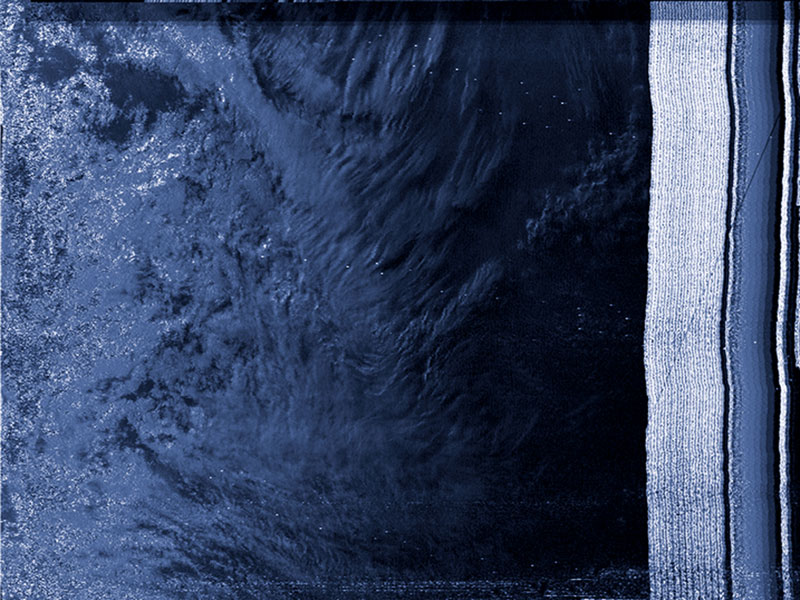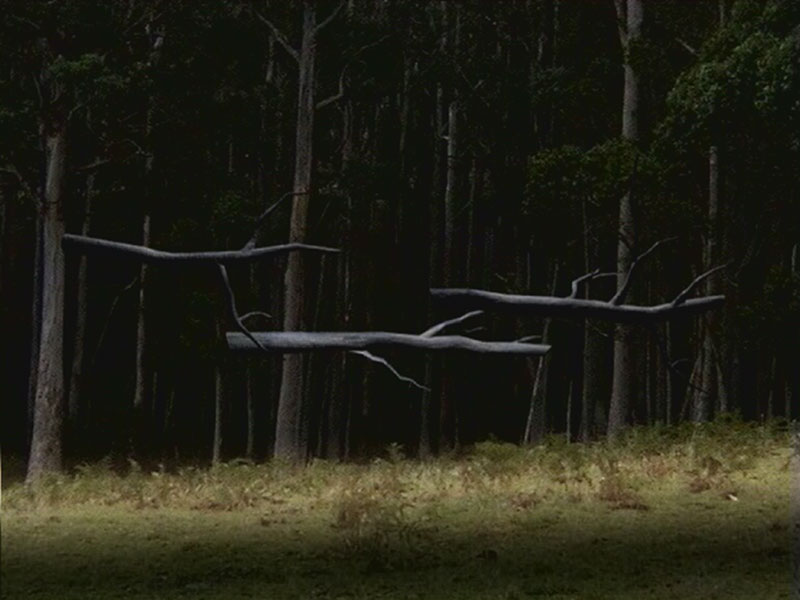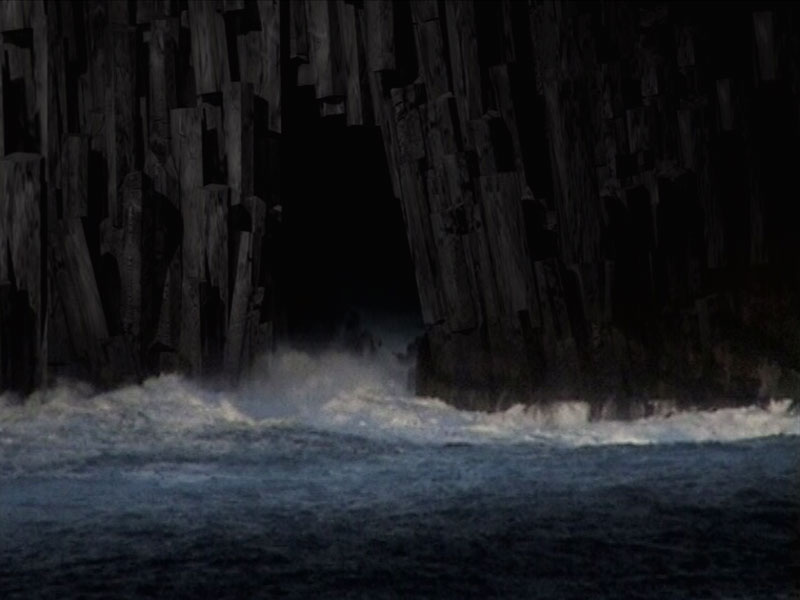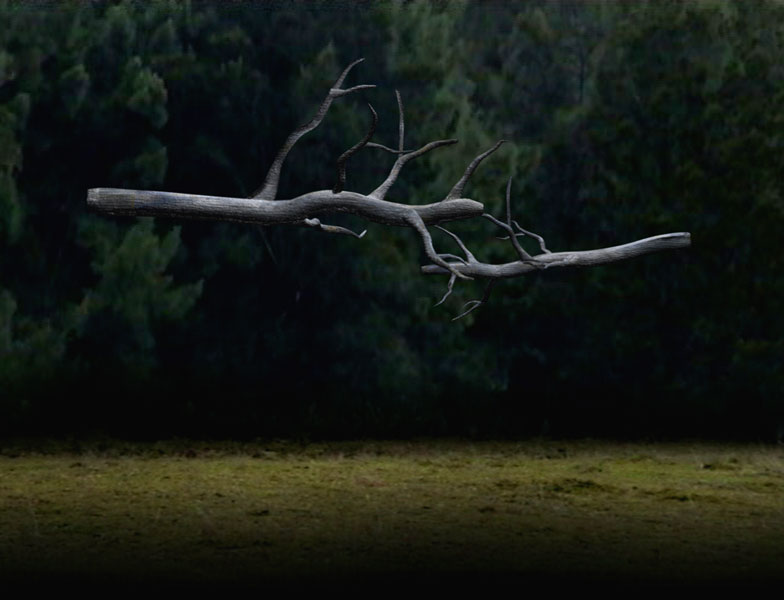2000 -Artspace, Sydney, Australia, 2002 – ARCO, Madrid, Spain, 2002 – st@rt up: new interactive media, Museum of New Zealand, Te Papa Tongarewa, Wellington, New Zealand, 2002 – MAAP, Multimedia Art Asia Pacific, The Art Museum of China Millennium Monument, Bejing, China, 2003 – CAST Hobart, Tasmania, Australia, 2005 – The Great Escapes, Lake Macquarie City Art gallery, NSW, Australia, 2006 – Senses of Place, Plimsoll Gallery, Hobart Tasmania, Australia, Four Channel DVD video installation Stereo and 5/1 Sound.
This work began on Bruny Island in Tasmania Australia as part of a residency in 1999 -2000. The residency at the Cape Bruny Light Station was supported by CAST, The National Parks and Wildlife Services and the New Media Arts fund of the Australia Council for the Arts.
The Soundtrack for this work is available on Sigma editions/Antiopic. The title of the CD that documents the sound from the installation is Spectral by Joyce Hinterding.
THE LEVITATION GROUNDS
Essay By Ann Finegan 2000
Setting: a clearing somewhere, dark, sombre, mysterious. Or, perhaps, the man-made edge of a long-forgotten cutting into the density of the forest. Place unknown clues, none. Something strange is happening. A number of fallen, weathered trees, their arms devoid of foliage, gently levitate in the air. They float quietly, rising and falling horizontally on unseen currents. They could be bodies or apparitions from a magician’s conjuring trick. A wrinkle in the fabric of the everyday world, an uncanny product of some manipulation, a trick played on the imagination? A disturbance in the natural order?
Hinterding and Haines have long flirted with the occult. Hinterding has produced a body of work exploring the unseen and, therefore, occulted world of electro-magnetic phenomena. Previously, her approach has been ‘scientific’, working with coils and currents, producing electrical storms and lightning inside the gallery (Electrical Storms, Koronatron). As such, she’s often played the role of magus, disrupting the order of things, just a little, displacing and corrupting natural events in order to allow the unseen to manifest. In Siphon, she coated a floor full of beer glasses with a conducting material and filled them with the sound of electricity. In the Aeriology series unbroken lines of fine copper wire were wound into sheer and shimmering coils the size of walls – antennae for listening in on the electro-magnetosphere. Aeritis, an imaginary project, traced the infection of everyday things with an electromagnetic virus. Things began to morph, giving off strange bands of light, in an event which could have happened.
The Levitation Grounds, while fictive, has an uncanny stake in what could be called the scientific real. Some strange kind of energy has affected this site, which is, after all, cleared of living trees. Energy patterns have been disturbed, intentionally or not, by some kind of anti-gravity effect. It’s science fiction without the aliens in spaceships. The kind of thing you could find on an alt-energy website, along with cold fusion and infinite energy generators. The trees float, slightly ridiculous, evident product of a computer conjuring trick, but they retain an eerie connection with legitimate science.
Haines, the other half of this partnership, has worked with what might be called the occult of the sign (Ghostship, Medievalism, The Universal Lever, and Liebniezian Sex). Across a series of works he has tracked rifts of disturbance in the symbolic order. He is especially drawn to ruptures in accordance with the sign of the natural world. Symbolic overlay never quite matches events. Put the wrong word or number on a thing, and you have created a mystery, a slippage, or a joke, which suddenly takes away our hold on things, rendering the worldview of the symbolic open to fractures and fissures. A strange name on a black funerary urn, “milk”, for example, collapses our comfortable relationship with language and with things (Vanishing 1233). “Milk” becomes a zero signifier, utterly disembodied. We no longer see the familiar white liquid with all its usual associations in the everyday world, or even the substance of poetry with its associative constellations of stars, sperm, breasts, nourishment and flows, but the rift of an emptied name. The symbolic and the real part company leaves a residue of the uncanny sense of a world haunted by forces that escape the mastery of the Signifier.
Combining these two sensibilities, Hinterding and Haines create a disturbingly familiar work. Sure, it’s part of the conjurer’s standard routine, but the idea of levitation has continued to fascinate the popular imagination. It’s part of the tradition of the uncanny, which we’ve lived through countless stories of strange recordings of paranormal events, ghostworks, and the like. And they all begin with a semblance of normalcy or scientific intervention gone slightly wrong.
The Levitation Grounds is the product of a residency at the remote lighthouse station of Bruny Island, deep in the southern ocean and off the remotest point of Tasmania. Initially, Hinterding and Haines set out to produce a landscape-driven work, one in which activity in the landscape was to be tapped to trigger the interfaces (satellite monitoring, digital tracking of sonorous and visual sources), which would record the event of Nature in progress. However, their immersion in the landscape was to become itself, a factor. Hinterding and Haines found themselves, like many early explorers, no longer third-party facilitators of the expedition or experiment but absorbed into a landscape that turned inwards. Into itself and into themselves. Haines began to email bulletins of odd sightings as he and Hinterding began tuning into the landscape, which was working its effects on their psyches.
As such, the possibility of psychic corruption of scientific observation cannot be dismissed. Nor even the prospect of quackery. Or inadvertent hoax. The results, presented as archival film – evidence as literal trace or mark – are, therefore, dubious and equivocal. Some parts are real, others, doctored, imaginary images. Legitimate capture or fake?
These recordings call to mind tales of explorers stumbling across their finds, and then against the scrutiny of an unbelieving scientific community. Much in the same way as a nineteenth century explorer would have snapped photographic evidence of the strange phenomenon of the Northern Lights, you can imagine Haines and Hinterding straying onto the scene of the levitating trees, digital camera on hand. We can almost imagine a future scientific report, explaining the phenomenon as the result of a peculiar and local electromagnetic disturbance – something along the lines of our acceptance of the explanation that the Northern Lights are the result of ionization of the upper atmosphere, and the burning of the air into coloured bands of light.
Even the satellite transcripts on exhibit, carry a degree of unbelievability. Haines and Hinterding duly recorded their passage, usually several times a day. Though they may, at first glance, appear scientifically legitimate, it must be said that they are prone to the unavoidable subjective tampering built into the original interface, which was designed to translate electronic flows into recognizable pictographic images. There’s no little man with a camera looking down, objectively, on the earth from a sputnik. The gallery audience, like the scientist, engages in a process of sifting seemingly abstract flows, whilst waiting for a recognizable stain, ‘mountain’ or ‘edge’, to emerge on the image screen. The satellite recordings are tainted with a fictographic bias: the data are manipulated in response to our desire to legitimately ‘see’ in pictures. Seeing is believing, as any successful magician knows.
Hinterding and Haines haven’t filtered the satellite outputs. They’ve intentionally left the noise and blanks, the latter which Haines refers to as “yawning voids”, in order not to dispel the occulted reserve of natural phenomena, when Nature decides not to yield. Satellites map, but ‘map what’? Recalibrate the interface and a different set of patterns, with no recognisable shapes, emerges. The behindness of things, their hidden occult, writes an undecipherable script in the recording medium. We’re left with mystery, absence and occasional flashes of presence.
Coda: The Third Scene.
Sliced alongside the satellite transcripts is a naturalistic scene of digital imagining. It’s a clue to reading the other image-texts. It looks real enough: a magnificent wall of brown dolomite opens its base to accommodate the washings of the sea. Look through the gap, and what you see is not the expected infinity of a Casper Freidrich sublime, suffused with divine light. The image might be framed to prepare the viewer for just such a glimpse of Kant’s sublime of nature – the massing of the powerful force of brown dolorite tamed to yield the spectacle of endlessness, the viewer safe, and contemplative – but, what happens is more akin to Surrealism and its trompe l’oeil tricks (Magritte suspending an island of stone over the sea).
The potential sublime is dispersed into a scattering. The eye isn’t carried onward and up but scans the surface and follows the sea through the gap in the wall to meet and rebound from the waves on the other side. The glance goes forward and back, literally breaking through what Haines calls “the wall of the natural sublime.” It’s a deliberate strategy, one that might be missed by a viewer seduced by the odd, if naturalistic beauty of the scene.
Hinterding and Haines were acutely aware that any project that engages with Nature and its representation would have to cope with an image culture that saturates Nature with the sublime. Show nature under a strong and powerful aspect, and the over-codings of the sublime multiply, as a guaranteed cultural effect. We’re habitués of the sublime of nature, trained to respond with awe and terror, then pacified with a sublimating halo. (The popular genre of natural disaster films incessantly repeats the gesture. Twister, for example, followed the pattern of initial awe, then tumult and destruction, resolving into hallowed light and happy ending.) Haines and Hinterding set out to evolve a work with Nature, which didn’t fall back into the predictable patterning of a sublime become mundane.
The scene of the seawall depicts nature as the anti-sublime. It refuses to yield anything but a familiar rhythm of the waves’ going forwards and backwards. This element works subliminally, a kind of ‘nothing going on here, folks’ that pushes you back to the mystery of the levitation scenes.
Hinterding and Haines have found a way to tap into the quieter, and spookier, underside of the power of Nature’s affect. Without grandiose machinations or taming Nature into a denatured pastoral idyll, they have sought an occult of force fields and levitation to engage with Nature as a mysterious science. The conjuring trick of the levitating trees is taken with a good measure of distance (it has to be seen to be believed) while retaining what may be called a healthy respect for the earthly unearthly.




